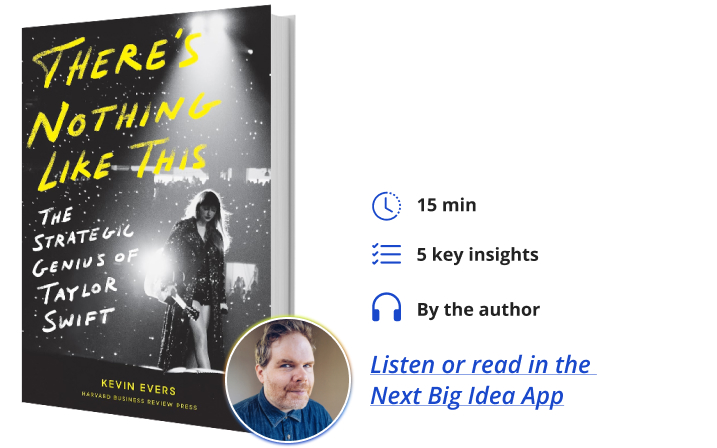Kevin Evers is a Senior Editor at Harvard Business Review. He has edited bestselling and award-winning books on high performance, creativity, digital disruption, marketing, and strategy. He has also written popular articles on brain science, Hollywood blockbusters, the art of persuasion, and the unpredictability of success.
What’s the big idea?
How does a mere mortal—in this case, an average American girl in a stars-and-stripes dress with a red cardigan—transform into a Beatles-esque global phenom? Taylor Swift was performing from a young age and showed potential for success, surely, but few could have anticipated the unprecedented level of stardom she’d reach. By pairing her talent and artistry with incredible entrepreneurial instincts, Swift is not only building a musical legacy; she has built a reputation for bold, effective fanbase development.
Below, Kevin shares five key insights from his new book, There’s Nothing Like This: The Strategic Genius of Taylor Swift. Listen to the audio version—read by Kevin himself—in the Next Big Idea App.

1. Seize opportunities others ignore.
A popular meme pops up in my social media feed whenever Taylor Swift breaks a new record or surpasses another milestone. There are multiple versions, but my favorite includes a picture of 12-year-old Swift as she grips a microphone with both hands, singing “The Star-Spangled Banner” at a 2002 Philadelphia 76ers game. Despite the grand setting of an arena, she looks like an ordinary girl. The caption reads: “Someone tell her she’s about to have the highest-grossing tour of all time.” In one image, in 14 words, the meme expresses the mystique of superstardom.
Taylor Swift’s early success as a teenage country music star was straight out of the entrepreneur’s playbook. She seized an opportunity that other people were ignoring. She had a clear vision. She wanted to write her own songs. She wanted to write those songs for an audience of her peers—teenage girls—and she wanted to put out an album as soon as possible.
But most executives and gatekeepers did not think this was a great strategy. Swift was told that, based on data and past failures, teenage girls were not a viable market in country music. But Swift persisted. And like Marvel did in the 1960s when it went after college students and young adults (a market DC and other comic-book publishers were ignoring), Swift created a category all her own.
2. Know what people are “hiring” you to do.
Swift has demonstrated a deep sense that her fans are hiring her to do more than write songs and perform music. Her fans want connection. They want intimacy. They want to forge deep and personal relationships with Swift herself.
“Her fans want connection.”
Swift infuses this knowledge into everything that she does. You can hear it in the way she sings her songs. The way she conveys emotions—line by line, word by word—in a near conversational tone. You can hear it in her hyper-specific lyrics that seem to give fans personal insights into Swift’s emotions and experiences. You can see it in her fan engagement strategies. The way she drops hints and encourages fans to dissect her lyrics like scholars analyze T.S. Eliot’s “The Waste Land” poem. And you can see it in the way she stages her live shows. They’re more like theatrical extensions of each album’s themes than traditional concerts.
Her deep knowledge and execution of the jobs her fans want done have enabled her to remain close to what her fans love and cherish while changing and adapting at the same time.
3. Be people-obsessed.
Taylor Swift is fan-obsessed, and her obsession has only increased as her popularity has grown. Her playbook is straight out of Amazon’s. In a 2016 shareholder’s letter, Jeff Bezos wrote that customers are always beautifully, wonderfully dissatisfied, even when they report being happy and business is great. Even when they don’t yet know it, customers want something better, and your desire to delight customers will drive you to invent on their behalf.
This has been Swift’s attitude her entire career. She has always gone above and beyond for her fans. She has sent fans Christmas presents. She has hosted listening sessions at her home. And she continually finds new ways to drop hints and increase engagement online.
The Eras Tour is a peak example of Swift’s fan obsession. Swift could have played a greatest hits show for two and a half hours. She’d never done something like that before, and her fans likely would have loved it. Instead, she played for three-and-a-half hours, her setlist spanned over 40 songs, and she devoted a mini-set to nearly every album of her career. This was borderline excessive. She didn’t need to do these things. But she did. She gave fans more than they expected, and perhaps even more than they deserved.
Swift understands that superstars are not self-made, they’re created by fans. Her ability to continually delight her fans is one of the reasons why she continually grows her fan base while encouraging old fans to stick around.
4. Be productively paranoid.
No matter how successful Swift has become, she has always shown a special trait that great leaders possess: productive paranoia. The term refers to the ability of a leader to anticipate future change and challenges even when things are going very well. According to research, leaders who are productively paranoid are better able to pivot and deal with challenges than those who aren’t.
Throughout her career, Swift has voiced on numerous occasions that she was worried that her popularity would dwindle, and she has used this fear to positive effect by making big changes when they wouldn’t seem otherwise necessary.
“Leaders who are productively paranoid are better able to pivot and deal with challenges than those who aren’t.”
In 2014, after three number-one albums in a row, she completely shifted from country music to pop music. For years, she had the best of both worlds. She had cornered the country market and her songs were widely played on pop radio. By moving completely to pop, she risked alienating half of her fan base.
At this point, Swift was four albums into her career—a perilous time for many artists, as seen by how many flame out around this milestone. Swift, trusting her instinct and evolving musical taste, decided to take a big risk. She chose change over the status quo, and it paid off. Her move to pop expanded her fan base and global reach.
5. Be a radical adapter.
Taylor Swift is on an unprecedented run. Her Eras Tour, which spanned 149 shows, earned more than two billion in revenue, making it the highest-grossing tour of all time. In 2024, according to HITS Daily Double, she alone accounted for nearly two percent of the total U.S. music market. None of this would have been possible if Swift hadn’t radically adjusted her strategies to adapt to the Streaming Age.
Daniel Ek, Spotify’s cofounder, stated at an industry event in 2020 that the traditional model of releasing music every two years loses out on purchases. Ek said, “The artists today that are making it realize that it’s about creating a continuous engagement with their fans. It’s about putting the work in, about the storytelling around the album, about keeping a continuous dialogue with your fans.” Much of Ek’s description sounded a lot like Swift strategies. The fan engagement, the hard work, the storytelling. These were the things she’s been doing better than anyone for nearly two decades.
“None of this would have been possible if Swift hadn’t radically adjusted her strategies to adapt to the Streaming Age.”
But Swift had been missing one critical piece: what Ek called “the continuous dialogue with your fans,” which in the Streaming Age meant a constant flow of new content. So Swift radically changed her release strategies. In just 15 months, starting in 2020, Swift put out two new studio albums and released 49 tracks, including bonus tracks, which averages out to about a track every week and a half. She didn’t stop there. Soon after, she released the first of her re-recordings, Fearless (Taylor’s Version). That meant three albums in less than 12 months, with all three landing atop the Billboard 200—the first time for a female artist. She followed that up with Red (Taylor’s Version), which also reached #1. Whatever reservation she may have had was gone. Since then, she has released two more re-recordings and two more new studio albums.
By embracing the realities of the Streaming Age and switching up her release strategies, she not only regained her foothold but also expanded her influence. The remarkable success of her recent projects is a testament to her ability to learn from challenges and pivot with agility.
Swift has shown that although she’s an exceptional songwriter and artist, she also has top-notch entrepreneurial instincts. She’s a double threat. Those instincts have played an outsized role in her career success.
Enjoy our full library of Book Bites—read by the authors!—in the Next Big Idea App:






























